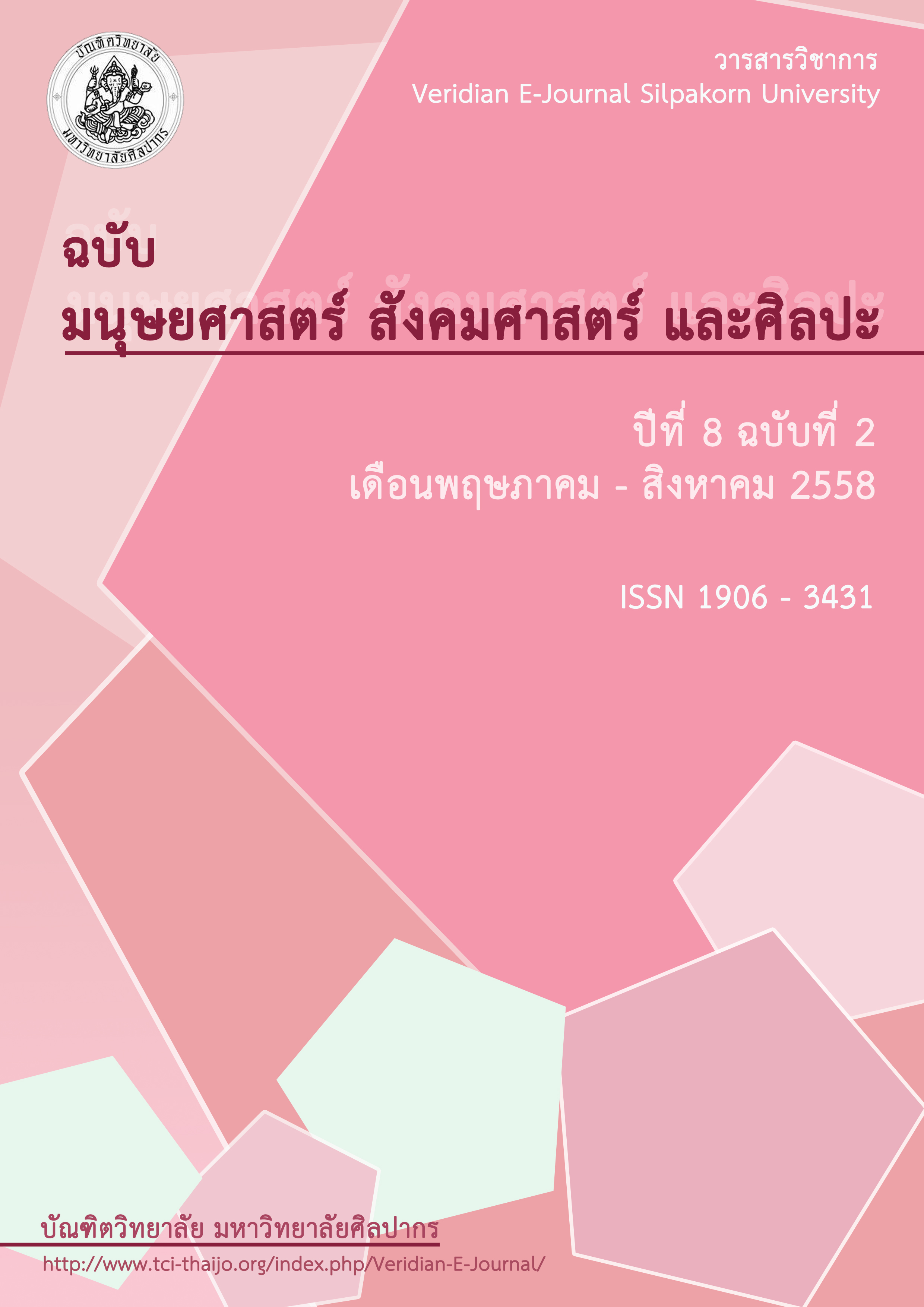ผลการจัดกิจกรรมการเรียนรู้คณิตศาสตร์ด้วยการเรียนรู้เชิงรุก ที่มีต่อความสามารถในการแก้ปัญหาและการให้เหตุผลทางคณิตศาสตร์ เรื่อง สถิติ ของนักเรียนชั้นมัธยมศึกษาปีที่ 3
Main Article Content
Abstract
บทคัดย่อ
การวิจัยครั้งนี้มีวัตถุประสงค์เพื่อ 1) เปรียบเทียบความสามารถในการแก้ปัญหาทางคณิตศาสตร์ หลังได้รับการจัดกิจกรรมการเรียนรู้คณิตศาสตร์ด้วยการเรียนรู้เชิงรุก เรื่อง สถิติ ของนักเรียนชั้นมัธยมศึกษาปีที่ 3 กับเกณฑ์ร้อยละ 70 และ 2) เปรียบเทียบความสามารถในการให้เหตุผลทางคณิตศาสตร์ หลังได้รับการจัดกิจกรรมการเรียนรู้คณิตศาสตร์ด้วยการเรียนรู้เชิงรุก เรื่อง สถิติ ของนักเรียนชั้นมัธยมศึกษาปีที่ 3 กับเกณฑ์ร้อยละ 70กลุ่มตัวอย่างเป็นนักเรียนชั้นมัธยมศึกษาปีที่ 3 ภาคเรียนที่ 2 ปีการศึกษา 2557 จำนวน 48 คน ได้มาจากการสุ่มแบบกลุ่ม (Cluster random sampling) เนื้อหาที่ใช้ในการวิจัยในครั้งนี้คือ สถิติ เครื่องมือที่ใช้ในการวิจัยประกอบด้วย 1) แผนการจัดการเรียนรู้คณิตศาสตร์ เรื่อง สถิติ จำนวน 9 แผน
ใช้เวลา 16 คาบ 2) แบบทดสอบวัดความสามารถในการแก้ปัญหาทางคณิตศาสตร์ ซึ่งมีค่าความเชื่อมั่นเท่ากับ 0. 841 และ 3) แบบทดสอบวัดความสามารถในการให้เหตุผลทางคณิตศาสตร์ ซึ่งมีค่าความเชื่อมั่นเท่ากับ 0. 731 และสถิติที่ใช้ในการวิเคราะห์ข้อมูล ได้แก่ ค่าเฉลี่ยเลขคณิต () ร้อยละ ส่วนเบี่ยงเบนมาตรฐาน () การทดสอบที (t-test) แบบ One sample
ผลการวิจัยพบว่า
1. ความสามารถในการแก้ปัญหาทางคณิตศาสตร์ของนักเรียนชั้นมัธยมศึกษาปีที่ 3 หลังได้รับการจัดกิจกรรมการเรียนรู้คณิตศาสตร์ด้วยการเรียนรู้เชิงรุก เรื่อง สถิติ สูงกว่าเกณฑ์ร้อยละ 70 อย่างมีนัยสำคัญทางสถิติที่ระดับ .05
2. ความสามารถในการให้เหตุผลทางคณิตศาสตร์ของนักเรียนชั้นมัธยมศึกษาปีที่ 3 หลังได้รับการจัดกิจกรรมการเรียนรู้คณิตศาสตร์ด้วยการเรียนรู้เชิงรุก เรื่อง สถิติ สูงกว่าเกณฑ์ร้อยละ 70 อย่างมีนัยสำคัญทางสถิติที่ระดับ .05
คำสำคัญ: การเรียนรู้ด้วยการเรียนรู้เชิงรุก/ ความสามารถในการแก้ปัญหาทางคณิตศาสตร์/ความสามารถในการให้เหตุผลทางคณิตศาสตร์/ สถิติ
Abstract
The purposes of this research were 1) to compare mathematical problem solving ability in statistics of Mathayomsuksa 3 students after receiving active learning activities with the criterion of 70%, and 2) to compare mathematical reasoning ability in statistics of Mathayomsuksa 3 students after receiving active learning activities with the criterion of 70%. The participants, selected by the cluster random sampling technique, were 48 Mathayomsuksa 3 students in the second semester of 2014 academic year. The content of the research is statistics. The research instruments used in this research consisted of 1) nine mathematics lesson plans (16 periods), 2) a mathematic problem solving test with the reliability of 0.841, and 3) a mathematic reasoning ability test with the reliability of 0.731. The statistics used for analyzing the data were mean (), percentage, standard deviation (), and t-test for one samples.
Research results found that;
1. Mathematical problem solving ability in statistics of Mathayomsuksa 3 students after receiving the active learning was higher than the criterion of 70% at the .05 level.
2. Mathematical reasoning ability in statistics of Mathayomsuksa 3 students after receiving the active learning was higher than the criterion of 70% at the .05 level.
Keywords: Active Learning/ Mathematical problem solving ability/Mathematical reasoning ability / Statistics
